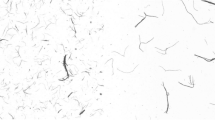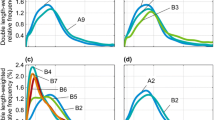Abstract
In this paper, Leucaena leucocephala sawdust was treated with glacial acid and sodium chloride to produce mushy and slivery fibre. The fibre morphology consists of fibre length, fibre diameter, lumen diameter, cell wall diameter, Runkel ratio and slenderness ratio. Approximate fibres morphology is often used to determine the size of fibres in wood species. Fibres dimension and morphology have an important effect on the physical and mechanical properties of wood composite such as medium density fibreboard (MDF) and insulation board. Fibre morphology properties of 5- and 3-year-old Leucaena leucocephala were collected. The images of fibre length, fibre diameter and lumen diameter were collected using an image analyser microscope. The data obtained were used to calculate the cell wall diameter, Runkel ratio and slenderness ratio. The result indicated that slenderness ratio was positively affected by the age of Leucaena leucocephala. The statistical analysis also shows that fibre length, cell wall diameter and Runkel ratio showed positive increase with increase of Leucaena leucocephala age. The results of intercorrelation indicated that the effect of the fibre morphology of Leucaena leucocephala on board properties was insignificant. Generally, the board properties are not depended on the variation of fibre morphology.
Access this chapter
Tax calculation will be finalised at checkout
Purchases are for personal use only
Similar content being viewed by others
References
Akgul M, Camlibel O (2008) Manufacture of medium density fiberboard (MDF) panels from rhododendron (R. ponticum L.) biomass. Build Environ 43(4):438–443
Akgul M, Tozluoglu A (2008) Utilizing peanut husk (Arachis hypogaea L.) in the manufacture of medium-density fiberboards. Bioresour Technol 99(13):5590–5594
Alvin D (1982) Clonal variation of wood density and fibre length of trembling aspen (Populus tremuloides Michx.) in North-Central Alberta. Thesis of Department of Forest Science, University of Alberta
Ates S, Ni YH, Akgul M, Tozluoglu A (2008) Characterization and evaluation of Paulownia elongota as a raw material for paper production. Afr J Biotechnol 7:4153–4158
Ayrilmis N, Buyuksari U, Avci E, Koc E (2009) Utilization of pine (Pinus pinea L.) cone in manufacture of wood based composite. Forest Ecol Manage 259(1):65–70
Cross CF, Bevan EJ (1907) A text book of paper making, 3rd edn. E. & F.N. Spon, London
Dean SD, Ryan S, Harrington CA, Gartner BL (2002) Wood density and fiber length in young populus stems: relation to clone, age, growth rate, and pruning. Wood Fiber Sci 34(4):529–539
Diaz MJ, Garcia MM, Tapias R, Fernandez M, Lopez F (2007) Variations in fiber length and some pulp chemical properties of Leucaena varieties. Ind Crops Prod 26:142–150
Doughty RH (1932) The relation of sheet properties and fiber properties in paper. Part 3, The variation of ultimate tensile strength with basic weight and related factors. Paper Trade J 94(9):29–34
Gbadamosi JO (2001) Evaluation of the structure of pulp and paper industry. Niger J Forest 20(3):45–49
Huber P, Roux JC, Mauret E, Belgacem N, Pierre C (2003) Suspension crowding for a general fiber-length distribution: application to flocculation of mixtures of short and long paper making fibers. J Pulp Pap Sci 29:77–85
Igartúa DV, Monteoliva SE, Monterubbianesi MG, Villegas MS (2005) Basic Density and fiber length at breast height of Eucalyptus globulus ssp. globulus for parameter prediction of the whole tree. IAWA Bull J 24(2):173–184
Lee BJ, McDonald AG, James B (2001) Influence of fiber length on the mechanical properties of wood-fiber/polypropylene prepreg sheets. Mater Res Innov 4:97–103
Majid K (2012) The influence of cambial age on fiber dimension in maple wood. Middle-East J Sci Res 11(8):1009–1012
Mark RE, Gillis PP (1983) Structure and structural anisotropy. In: Mark RE, Murakami K (eds) Handbook of physical and mechanical testing of paper and paperboard. Marcel Dekker Inc., New York, NY, pp 283–371
McDicken KG, Brewbaker JL (1982) Descriptive summaries of economically important nitrogen fixing trees. Nitrogen Fixing Tree Research Reports 2, Hawaii, pp 46–54
Misra PN, Tewari SK, Singh D, Katiyar RS (1995) Effect of coppicing height on the regeneration and productivity of certain firewood shrubs in alkaline soils of north Indian plains. Biomass Bioenerg 9:459–463
Okigbo BN (1984) Nitrogen-fixing trees in Africa: priorities and research agenda in multiuse exploitation of plant resources. Pesq Agropec Bras 19:325–330
Panshin AJ, De Zeeuw C (1980) Textbook of wood technology, 4th edn. McGraw-Hill, New York, p 722
Tang JL (1981) Properties of wood from planted, fast-grown Leucaena in Taiwan. Leucaena Research Reports 2, Hawaii, pp 57–58
Viena LS, Trugilho PF, Gherardi Hein PR, Lima JT, Mareiro da Silva JR (2009) Predicting the morphology characteristics and basic density of Eucalytus Wood using the NIRS technique. Cerne 15(4):421–429
Zobel BJ, Sprague JR (1998) Juvenile wood in forest tress. Springer, Berlin
Acknowledgements
The authors are grateful for the support of the KTP Research, Grant. No. 703000 13 0002, Universiti Teknologi MARA (UiTM) Pahang, Daiken Sarawak and Forest research instituted of Malaysia (FRIM).
Author information
Authors and Affiliations
Corresponding author
Editor information
Editors and Affiliations
Rights and permissions
Copyright information
© 2018 Springer Nature Singapore Pte Ltd.
About this paper
Cite this paper
Razali, N.A., Johari, N.A.N., Wan Abdul Rahman, W.M.N., Kasim, J., Misran, S. (2018). Fibre Morphology of Leucaena leucocephala Wood: Effects on Fiberboard. In: Yacob, N., Mohd Noor, N., Mohd Yunus, N., Lob Yussof, R., Zakaria, S. (eds) Regional Conference on Science, Technology and Social Sciences (RCSTSS 2016) . Springer, Singapore. https://doi.org/10.1007/978-981-13-0074-5_79
Download citation
DOI: https://doi.org/10.1007/978-981-13-0074-5_79
Published:
Publisher Name: Springer, Singapore
Print ISBN: 978-981-13-0073-8
Online ISBN: 978-981-13-0074-5
eBook Packages: Business and ManagementBusiness and Management (R0)




